Related Research Articles

Bangladesh, officially the People's Republic of Bangladesh, is a country in South Asia. It is the eighth-most-populous country in the world, with a population of around 169 million people in an area of 148,460 square kilometres (57,320 sq mi). Bangladesh is among the most densely populated countries in the world, and shares land borders with India to the west, north, and east, and Myanmar to the southeast; to the south it has a coastline along the Bay of Bengal. It is narrowly separated from Bhutan and Nepal by the Siliguri Corridor; and from China by the Indian state of Sikkim in the north. Dhaka, the capital and largest city, is the nation's political, financial and cultural centre. Chittagong, the second-largest city, is the busiest port on the Bay of Bengal. The official language is Bengali, one of the easternmost branches of the Indo-European language family.
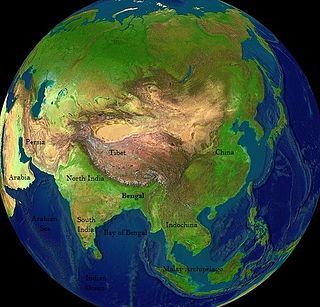
Bengal is a historical geographical, ethnolinguistic and cultural term referring to a region in the eastern part of the Indian subcontinent at the apex of the Bay of Bengal. The region of Bengal proper is divided between modern-day Bangladesh and the Indian state of West Bengal. The Indian states of Assam and Tripura have a sizeable Bengali population. A large Bengali diaspora exists across the world. Bengali is the sixth-most spoken language in the world.
The Partition of Bengal in 1947, part of the Partition of India, divided the British Indian Bengal Province along the Radcliffe Line between the Dominion of India and the Dominion of Pakistan. The Bengali Hindu-majority West Bengal became a state of India, and the Bengali Muslim-majority East Bengal became a province of Pakistan.

Maulana Azad College is a public institute of liberal arts, commerce and science in India, located in central Kolkata, West Bengal, India. The college is fully government-administered. It is located near the junction of Rafi Ahmed Kidwai Road and SN Banerjee Road, popularly called "Lotus crossing".

Boro, also rendered Bodo, is a Sino-Tibetan language spoken primarily by the Boros of Northeast India and the neighboring nations of Nepal and Bangladesh. It is an official language of the Indian state of Assam, predominantly spoken in the Bodoland Territorial Region. It is also one of the twenty-two languages listed in the Eighth Schedule of the Constitution of India. Since 1975 the language has been written using the Devanagari script. It was formerly written using Latin and Eastern-Nagari scripts. Some scholars have suggested that the language used to have its own now lost script known as Deodhai.

The East Pakistan Provincial Assembly, known as the East Bengal Legislative Assembly between 1947 and 1955, was the provincial legislature of East Pakistan between 1947 and 1971. It was known as the East Bengal Assembly from 1947 to 1955 when the provincial name was changed. The legislature was a successor to the Bengal Legislative Council and the Bengal Legislative Assembly, which were divided between East Bengal and West Bengal during the partition of Bengal in 1947. It was the largest provincial legislature in Pakistan. Elections were held only twice in 1954 and 1970.
East Bengali Refugees are people who left East Bengal following the Partition of Bengal, which was part of the Independence of India and Pakistan in 1947. An overwhelming majority of these refugees and immigrants were Bengali Hindus. During the Bangladesh liberation war with West Pakistan, an estimated ten million people of East Pakistan fled the country and took refuge in India particularly in the Indian states of West Bengal and Indian North East region, especially Tripura and Assam.

Eastern Bengal and Assam was an province of India between 1905 and 1912. Headquartered in the city of Dacca, it covered territories in what are now Bangladesh, Northeast India and Northern West Bengal.
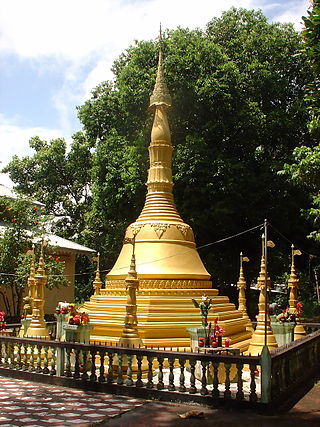
The Barua, are a Bengali-speaking ethnic group native to Chittagong Division in Bangladesh, Rakhine State in Myanmar, where they are known as the Maramagyi or Maramagri, West Bengal and Tripura in northeast India. According to Arakanese chronology, the Barua Buddhists have lived there for five thousand years. Another derivation of 'Barua' is 'Baru' and 'Arya' meaning great arya. They are commonly identified by their last name, "Barua". Barua is derived from "Baru" meaning "great" and "ua", meaning "noble rulers". In Myanmar, the Barua is classified as one of the seven groups that make up the Rakhine nation.

Nawab Sir Khwaja Salimullah Bahadur was the fourth Nawab of Dhaka and one of the leading Muslim politicians during the British rule in India.
Major Abdul Gani was a Bengali Muslim military officer, who is considered the co-founder of the East Bengal Regiment.
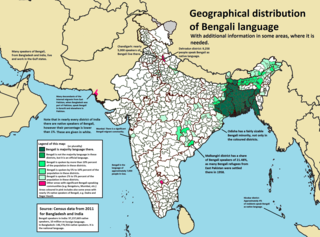
Bengali, generally known by its endonym Bangla, is an Indo-Aryan language native to the Bengal region of South Asia. With approximately 234 million native speakers and another 39 million as second language speakers as of 2017, Bengali is the sixth most spoken native language and the seventh most spoken language by the total number of speakers in the world. Bengali is the fifth most spoken Indo-European language.
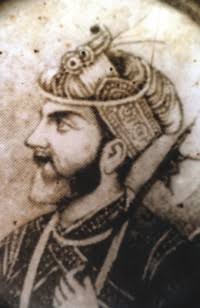
Bhuiyan was a title of Big landowners in Mediaeval Bengal and Assam. It has been adopted as a surname by different communities in West Bengal, Assam, and Bangladesh.

Bengali Hindus are an ethnoreligious population who make up the majority in the Indian states of West Bengal, Tripura, Andaman and Nicobar Islands, Jharkhand, and Assam's Barak Valley region. In Bangladesh, they form the largest minority. They are adherents of Hinduism and are native to the Bengal region in the eastern part of the Indian subcontinent. Comprising about one-thirds of the global Bengali population, they are the second-largest ethnic group among Hindus after Hindustani Hindus. Bengali Hindus speak Bengali, which belongs to the Indo-Aryan language family and adhere to Shaktism or Vaishnavism of their native religion Hinduism with some regional deities. There are significant numbers of Bengali-speaking Hindus in different Indian states. According to the census in 1881, 12.81 percent of Bengali Hindus belonged to the three upper castes while the rest belonged to the Shudra and Dalit castes.
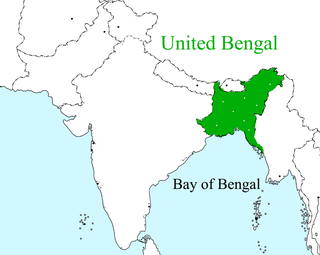
Greater Bangladesh, Greater Bengal, United Bengal represents the ideological assertion that Bengal will inevitably expand its sphere of influence to include the Indian states that currently has, or historically had, large populations of ethnic Bengali people. These include Sikkim to the north, and the states of Arunachal Pradesh, Assam, Meghalaya, Tripura, Mizoram, Manipur, and Nagaland in the east. The first and only real attempt at forming such an entity was made in 1943 by the Indische Legion under Indian Bengali Nationalist Netaji Subhas Chandra Bose, de facto leader of the Azad Hind movement. Such endeavors, however, failed to ultimately materialize due to Germany and Japan’s loss in World War II.

The Eastern Bengal Railway was one of the pioneering railway companies that operated from 1857 to 1942, in the Bengal and Assam provinces of British India.

The Assam Bengal Railway (ABR) was one of the pioneering railway companies in British India. Headquartered in Chittagong, it functioned from 1892 to 1942.

Bengali Muslims are adherents of Islam who ethnically, linguistically and genealogically identify as Bengalis. Comprising about two-thirds of the global Bengali population, they are the second-largest ethnic group among Muslims after Arabs. Bengali Muslims make up the majority of Bangladesh's citizens, and are the largest minority in the Indian states of West Bengal, Tripura and Assam.
Badarpur railway station serves the Indian city of Badarpur in Assam. It belongs to Lumding railway division of Northeast Frontier Railway of India. It is located at Cachar district in the state of Assam. It is one of the oldest station of India built in 1898. The Station connects Badarpur to other regions of Barak Valley as well as many parts of India.

The 1947 Sylhet referendum was held in the Sylhet District of the Assam Province of British India to decide whether the district would remain in Undivided Assam and therefore within the post-independence Dominion of India, or leave Assam for East Bengal and consequently join the newly-created Dominion of Pakistan. The referendum's turnout was in favour of joining the Pakistani union; however, the district's Karimganj subdivision remained within the Indian state of Assam.
References
- 1 2 "Bangladesh Sanskrit and Pali Education Board". Banglapedia. Retrieved 1 December 2017.
- ↑ "Results of Sanskrit, Pali published". The Daily Star. BSS. Archived from the original on 1 December 2017. Retrieved 1 December 2017.
- ↑ "PM working for welfare of all religious communities: NBSPEC". bssnews.net. BSS. Archived from the original on 1 December 2017. Retrieved 1 December 2017.